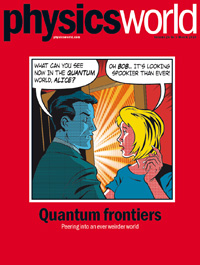By Matin Durrani

Physics World March 2013.
If you’re a member of the Institute of Physics, it’s time to get stuck into the March 2013 issue of Physics World, which is a special issue devoted to some of the most interesting cutting-edge work at the frontiers of quantum physics.
Among the highlights are a look at the fascinating new paradigm of “weak measurement”, the application of quantum physics to biology, the use of cold atoms to simulate the quantum world, and the use of entanglement for completely secure satellite communication. Two other articles examine the impact of quantum physics on popular culture and among the physics community itself.
The issue also contains some great multimedia, including the latest in our 100 Second Science video series where physicists at Imperial College London answer key questions in quantum physics in 100 seconds or less.
And if you’re wondering about the cover – it was specially commissioned by us in the style of pop artist Roy Lichtenstein, and shows Alice and Bob (the names given by convention to those sending and receiving quantum signals) peering into an ever weirder quantum world. The illustration echoes a similar image that graced the cover of our last special issue on quantum physics exactly 15 years ago this month. That one was also commissioned by us and was voted in 2008 by Physics World readers as one of their favourite covers of all time.
Members of the Institute of Physics can access the entire new issue online through the digital version of the magazine or by downloading the Physics World app onto your iPhone or iPad or Android device, available from the App Store and Google Play.
For the record, here’s a rundown of highlights of the issue:
• Nuclear physics faces loss of collider – A government panel in the US has recommended the closure of the hugely successful Relativistic Heavy Ion Collider at Brookhaven National Laboratory if funding for nuclear physics is not increased, as Peter Gwynne reports
• L’Aquila scientists appeal conviction – Formal appeals are to be made by the seven researchers who were charged with manslaughter for advice they gave prior to the 2009 L’Aquila earthquake, as Edwin Cartlidge reports
• The quantum moment – Quantum mechanics, says Robert P Crease, has finally acquired as much cultural influence as Newtonian mechanics, though via a very different path
• Agreeing to disagree – A recent poll has highlighted physicists’ differing views over the interpretation of fundamental aspects of quantum theory, but Maximilian Schlosshauer argues that it might not be so bad
• The curious state of quantum physics – Spooky, random and incompatible with gravity – that’s the old news for quantum physics. Now we can measure the state of a wavefunction without it “collapsing” and have plans to quantum-communicate with satellites in space. Vlatko Vedral brings you up to speed with the latest mysteries of the quantum world
• In praise of weakness – Quantum physics is being transformed by a radical new conceptual and experimental approach known as weak measurement that can do everything from tackling basic quantum mysteries to mapping the trajectories of photons in a Young’s double-slit experiment. Aephraim Steinberg, Amir Feizpour, Lee Rozema, Dylan Mahler and Alex Hayat unveil the power of this new technique
• Nature’s quantum subways – Jim Al-Khalili describes the new experiments and theories exploring whether quantum tunnelling of hydrogen causes mutations in our DNA
• Quantum leaps for simulation – Immanuel Bloch describes how recent experiments with ultracold atoms are bringing us closer to realizing Richard Feynman’s dream of a universal quantum simulator
• Quantum space race – Sending satellites equipped with quantum technologies into space will be the first step towards a global quantum-communication network. As Thomas Jennewein and Brendon Higgins explain, these systems will also enable physicists to test fundamental physics in new regimes
• A physics primer, with equations – Lowry Kirkby reviews The Theoretical Minimum: What You Need to Know to Start Doing Physics by Leonard Susskind and George Hrabovsky
• An iconoclast’s career – Philip Anderson reviews Maverick Genius: the Pioneering Odyssey of Freeman Dyson by Phillip Schewe
• The pleasure of finding things out – The ability to research a problem is one of many “soft skills” that serves physics graduates well in the job market, as Nadya Anscombe describes
• Medal-winning presentations – Sharon Ann Holgate examines how lessons from sports psychology can help physics graduates win over their audiences when it matters
• Dealing with criticism – Physics graduates are accustomed to receiving feedback from teachers, tutors and lecturers, but different expectations and norms prevail in the workplace. Giles Morris discusses how to handle criticism at work
• The incomprehensibility principle – This month’s Lateral Thoughts column features the final article written by former CERN Courier editor Gordon Fraser, who died in January
If you’re not yet a member, you can join the Institute as an IOPimember for just £15, €20 or $25 a year. Being an IOPimember gives you a full year’s access to Physics World both online and through the apps.
Guidelines
Show/hide formatting guidelines
this text was deletedwhere people live in harmony with nature and animals</q>
Some text